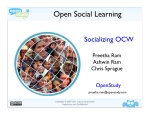Open Social Learning aka Massively Multiplayer Online Learning
Posted by Preetha Ram
 Access to education is a major problem for most governments. How big is this problem? According to Sir John Daniel (1996), “More than one-third of the world’s population is under 20. By 2006, 100 million qualified to enter a university will have no place to go. To meet this staggering demand, a major university needs to be created each week.” Today, that is about 4 universities a week. Clearly that is not happening. How then do we educate the millions?
Access to education is a major problem for most governments. How big is this problem? According to Sir John Daniel (1996), “More than one-third of the world’s population is under 20. By 2006, 100 million qualified to enter a university will have no place to go. To meet this staggering demand, a major university needs to be created each week.” Today, that is about 4 universities a week. Clearly that is not happening. How then do we educate the millions?
OpenCourseWare Consortium (OCWC) and the Open Education movement is addressing this question of access by providing millions access to high quality courses developed in the best institutes of higher learning like MIT and Johns Hopkins. And yet is that enough? Anyone, whether educator or student, knows that learners always need help, and learning alone is, well, boring. In the Gates Foundation “Silent Epidemic” study, 88% of the dropouts studied had passing grades. They could have passed, but even in a school were too bored to finish. When you consider distance or online learning you just ring in the death knell. As George Siemens says of online courses, “Great video and talented presenters. My only complaint: I’d like to interact with others who are viewing the resources. Creating a one-way flow of information significantly misses the point of interacting online.” In the same Gates Foundation study, researchers learned that 47% of dropouts say “classes are not interesting.” Other studies show 60% find video lectures “boring” and 60% read less when using e-textbooks. These are the key problems of education: how to bring help to online learners, how to scale it, and how to add interaction so learners are kept engaged.
In my talk at OCW Consortium Global 2011 meeting last week at MIT, I raised these issues. I talked about the notion of Open Social Learning and how it could solve these two problems. The solutions are based on some wonderful and established work in the learning sciences. Leve and Wenger (1991) proposed the theory of a community of practice where members come together with a common passion or a need to do something, to learn something. In such a community, learning is enhanced through interactions, encouragement, role models and support. Peer-to-peer learning allows learners to help one another, benefitting both the learners and the tutors (Fuchs, 1997). Best of all, it is scalable to the millons.
Our Open Social Learning solution to these three problems of education is therefore elegantly simple. In this solution OpenCourseWare courses are augmented by a community of learners who help one another, support one another and learn together as they socialize and spend time together online. Not only is this solution validated by educational research, it is also eminently scaleable because you are not dependent on hiring tutors or teachers to spend time assisting self learners. The community helps one another. Open Social Learning also fits right in with what our digital millenials want to do: hang out online for hours! Why not get them talking about math instead of … well, let’s not go there.
Our solution is available at OpenStudy.com. We think of it as Massively Multiplayer Online Learning. What do you think?
About Preetha Ram
I am an educator (Dean for PreHealth and Science Education at Emory), social entrepreneur (Cofounder of OpenStudy, a global study group to connect learners) and visionary (let's build a classroom for the world to study together). A chemist by training (Yale), I like to solve problems by building bridges at the edges and interstices of disciplinary boundaries.Posted on May 11, 2011, in E-learning, open social learning. Bookmark the permalink. 3 Comments.
Hi Preetha, enjoyed your MOOC webinar on Monday (23rd Jan 2012).
In the slideshow, at the bottom, they have the Owl of Minerva spreading his wings. Ominous: http://en.wikipedia.org/wiki/Owl_of_minerva
Pingback: Open Social Learning aka Massively Multiplayer Online Learning « Cognitive Computing
Pingback: SoCS Computational Models and Techniques: A Case Study « Cognitive Computing